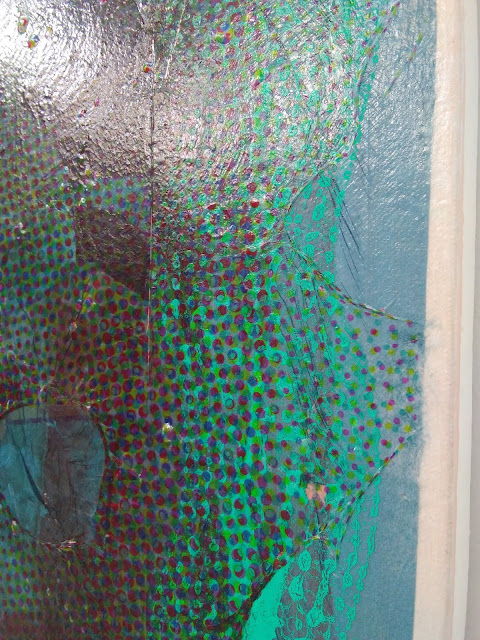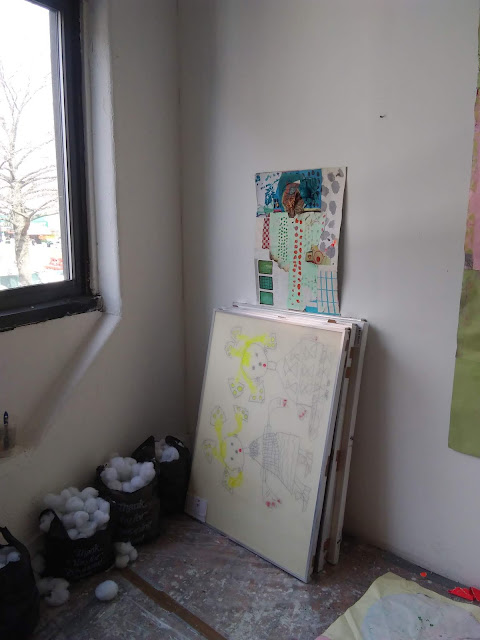Thursday, November 21, 2019
Saturday, November 16, 2019
Sunday, October 27, 2019
Sunday, September 8, 2019
Xylor Jane at Canada | Video
.
Xylor Jane: 3Lakes
September 7 - October 19, 2019 canadanewyork.com
CANADA
60 Lispenard Street
New York, NY 10013
.
Thursday, August 29, 2019
Saturday, August 3, 2019
Sunday, July 21, 2019
Friday, July 5, 2019
Sunday, June 2, 2019
Saturday, May 11, 2019
Sunday, April 14, 2019
Sunday, March 24, 2019
Brian Belott Studio Visit
 |
| Brian Belott with one of his frozen pieces. |
It's rare when one comes across an artist whose work is so wild, so unique, that even their storage system is like nothing ever seen in a studio before. I was already aware of the frozen artworks of Brian Belott, but on a recent visit to his studio, I wasn't quite prepared when he opened the door to his chest freezer, reached in and started showing me what was inside--it seemed like he was reaching into another world. Retrieved from the icy appliance were an array of astonishing pieces made from a variety of household items such as hair gel, toothpaste, plastic novelties, Play-doh and string--all suspended in blocks of frozen water.
During the visit, Brian also took the time to show me samples from all his distinct lines of work. I've always thought that one sign of a great artist is the ability to flip from one medium or way of working to something completely different while maintaining the primacy of their message and the continuity of their overall body of work. I was shown hand-made artist books, self-published books yet to be released, reverse glass paintings, collaged thrift store pieces, puff paintings, and some very large works on paper with colored sand mixed in the paint. It was aesthetic overload, but it was bliss.
We also carried on a long discussion involving our personal views on art as we ambled through the space. Brian shared how he's researched the writings and archive of Rhoda Kellogg, a champion of children's art in the 1960s and 70s. Additionally, Belott's own personal connection to that genre also runs deep as he recently organized an exhibition about Kellogg and her work at White Columns in January of this year.
Throughout our visit, I was given strong doses of information about art history, past and recent, along with the sense that Brian Belott knows who he is and where he's going as an artist. His incisive knowledge of art, coupled with his constant searching for new ground is what makes him one of the most exciting artists working today, and it's also what makes his inclusion in the 2019 Whitney Biennial so essential.
 |
| Here's a sneak peek (and three more below) of Brian's yet to be released and aptly titled book, FRIGIDAIRE. |
 |
| Bags of colored sand. |
Sunday, March 17, 2019
Joseph Montgomery Studio Visit
 |
| Shim piece, gouache and gesso on wood shims and canvas. |
This past week I took a trip to NYC. During my stay, I saw a lot of art and visited a couple of studios. One of my first stops was at Matthew Marks Gallery to see the Jasper Johns show. Shortly after I arrived there, a woman arrived whom I thought I had seen somewhere before. I said hello and said I thought I had seen a documentary about her and asked, "Are you," "Yes, I'm Susan Weil," she answered. I then said, "Weren't you were married to," and before I could finish, she said, "Robert Rauschenberg, yes." We spoke briefly before she continued viewing the exhibition, and she said that she had made a special effort to see the work as she and Jasper Johns have been friends over the years. You never know who you'll run into in the city.
 |
| Joseph Montgomery studio. |
My next stop was the studio of Joseph Montgomery, who I interviewed back in 2014. Situated in an industrial building in Long Island City, the site seemed quite active with woodworker's shops in part of it, along with a variety of other studios and workshops. Leaned against the wall inside Joe's studio were several of his paintings made with very thin pieces of paint-saturated Thai paper layered on top of one another. Some pieces had been run through a printer prior to any paint application, which added even more visual information to the work. In some cases, air bubbles formed in the paper/paint-skin, lending themselves as residual artifacts of the production that went into them.
Joe also works with wood shims, both small and very large. His smaller painted shim pieces have a band of canvas around the perimeter and coatings of gesso, then gouache for the final paint layer. Spotted near the back and tucked into one corner were a few eight-foot long wood shims, ala somewhat Claes Oldenburg in scale, which are sourced from a wood shop with a set-up large enough to cut them properly. In some examples, they've been used in combination to create elegant wall-mounted sculptures with a strong vertical orientation.
As we visited, we covered a lot of ground about materials and processes, exchanging notes on the particular things that are working best for each of us. Process is a crucial consideration in Joe's work as many of his pieces are constructed of various parts which are set in place to hold together over time. The evidence of process is also one of the strengths of the work as one can clearly see nearly every move made in their creation, and that added layer of interest means sustained viewing in order to take in all that went into each piece. I look forward to seeing how his work progresses over time.
Many thanks to Joseph Montgomery for taking the time for this visit. More of his work can be seen at: josephmontgomery.com and durstbrittmayhew.com.
 |
| Detail of piece shown above; notice the air bubble in the paint skin near the middle. |
 |
| Detail of work shown above. |
 |
| Paint-skins made of Thai paper saturated with acrylic paint. |
 |
| More paint-skins. |
 |
| Detail of work shown above. |
Joe also works with wood shims, both small and very large. His smaller painted shim pieces have a band of canvas around the perimeter and coatings of gesso, then gouache for the final paint layer. Spotted near the back and tucked into one corner were a few eight-foot long wood shims, ala somewhat Claes Oldenburg in scale, which are sourced from a wood shop with a set-up large enough to cut them properly. In some examples, they've been used in combination to create elegant wall-mounted sculptures with a strong vertical orientation.
 |
| Large wood shims are leaning in the corner behind the chair. |
As we visited, we covered a lot of ground about materials and processes, exchanging notes on the particular things that are working best for each of us. Process is a crucial consideration in Joe's work as many of his pieces are constructed of various parts which are set in place to hold together over time. The evidence of process is also one of the strengths of the work as one can clearly see nearly every move made in their creation, and that added layer of interest means sustained viewing in order to take in all that went into each piece. I look forward to seeing how his work progresses over time.
Many thanks to Joseph Montgomery for taking the time for this visit. More of his work can be seen at: josephmontgomery.com and durstbrittmayhew.com.
*
Subscribe to:
Posts (Atom)








































